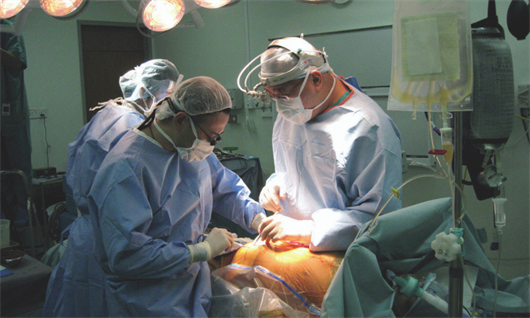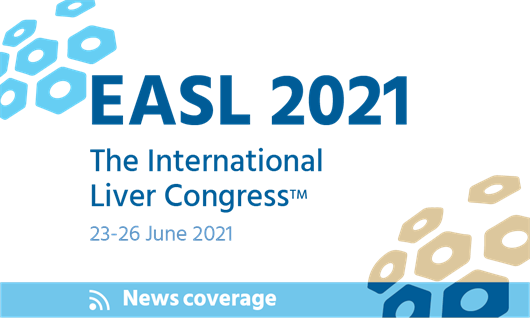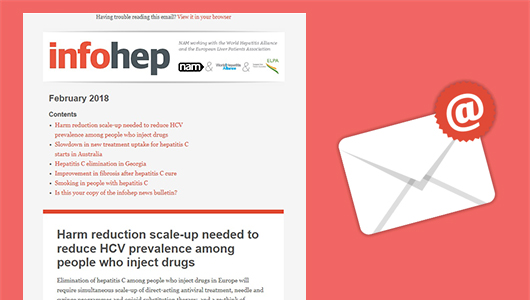Having trouble reading this email? View it in your browser
| |
June 2021 | |
Liver transplant outcomes improve in people with HIV and hepatitis C
Tareq Salahuddin. Creative Commons licence. Survival after a liver transplant has improved significantly in people with HIV and hepatitis C co-infection since the introduction of direct-acting antiviral treatment for hepatitis C, US researchers report in the journal Transplantation Direct. Due to faster progression of liver damage in people co-infected with HIV and hepatitis C, people with both viruses are especially likely to develop end-stage liver disease and require a liver transplant. Prior to the introduction of direct-acting antiviral (DAA) therapy from 2013, people with HIV had worse outcomes after liver transplantation, irrespective of hepatitis C co-infection. Review of US liver transplant records showed that between 2008 and 2019, 64,860 liver transplants were carried out in people with a known HIV status. In the pre-DAA period, 24,238 transplants took place, 68 in co-infected people and 49 in people with HIV alone. Transplant recipients with HIV were younger and had shorter waitlist times than other recipients, while all transplant recipients without hepatitis C had higher MELD scores, indicating more severe liver damage, and were more likely to be on life support at the time of transplantation. People with HIV and hepatitis had a significantly higher risk of graft failure (hazard ratio 1.85, 95% CI 1.31-2.59) in the pre-DAA era compared to people without either virus. This difference in risk disappeared in the DAA era, so that by three years after transplant, 81% of recipients with HIV and hepatitis C remained alive and had not suffered rejection of the donor organ (graft failure), compared with 58% in the pre-DAA era (p = 0.006). Survival was 100% over a median follow-up period of 656 days among graft recipients with HIV who had chronic hepatitis C at the time of transplant. Three-year graft survival in people who were not co-infected with HIV and hepatitis C was similar; 80% of people with HIV alone, 83% of people with hepatitis C alone and 84% of people with neither virus remained alive without rejection of the donor organ. Overall survival did not differ either; 84% of people with HIV and hepatitis C remained alive after three years, compared to 81% in people with HIV alone, 84% in people with hepatitis C alone and 86% in people without either virus. Survival in the 46 recipients of livers from HIV-positive donors did not differ from the overall survival; 82% of people with HIV who received a graft from an HIV-positive donor remained alive without rejection of the donor organ after three years. The study investigators say that their findings should encourage greater referral of people with HIV with end-stage liver disease for liver transplant assessment. They also encourage liver specialists to make use of the 2013 HOPE Act, which authorised the use of organs from HIV-positive donors for transplants to people living with HIV, to improve access to donor organs. Related linksWhat happens after curing hepatitis C? Avoiding, minimising or accepting the risks of re-infection
VladOrlov/Shutterstock.com Swiss men living with HIV approach the risk of re-infection with hepatitis C after cure in different ways, based on recent qualitative research by Dr Patrizia Künzler-Heule and colleagues from the Universities of Basel and Zurich. They describe three distinct groups: those who choose to avoid risks and aim not to get re-infected, those who minimise risks and chance re-infection and those who accept risks and the possibility of re-infection and repeated treatment. Some participants felt strongly about not getting re-infected with hepatitis C. They changed their behaviour to avoid reinfection, often prior to starting treatment or the behavioural intervention. These men expressed shock about their diagnoses, as they tended to associate hepatitis C with intravenous drug users. Some of the changes these men made included using condoms for anal sex, avoiding rough sexual activities (such as fisting) and avoiding sexualised drug use. For this group, re-infection was viewed as a personal failure. Those who aimed to minimise their risk did not believe they were able to avoid risk completely. Many of them had been engaging in condomless anal sex with multiple partners for a long period before receiving their diagnoses. These men gained new knowledge regarding transmission during the behavioural counselling, like the risks of hepatitis C transmission from using anal douching equipment or sharing straws when taking drugs. While they gained a better understanding of their individual risk behaviours, they did not view regular condom use as a realistic option. Instead, they focused on ‘feasible’ changes like using gloves for fisting, not sharing sex toys and decreasing the number of sexual encounters. The third group accepted the risks that accompanied their behaviour as they viewed behaviour change as requiring considerable effort, whereas they perceived medical treatment as an easier option. Thus, they accepted – and even expected – multiple rounds of treatment or possibly living with a chronic hepatitis C infection. However, they were concerned about disclosure and the possibility of sexual rejection. As these men saw little possibility of changing their risk behaviours, the only reasonable restriction for them that emerged from the behavioural counselling was to have fewer sexual encounters and hope increased testing and cure would lead to less hepatitis C in the community. Direct-acting antiviral treatment was viewed not only as a means to cure infection, or to give ‘the liver a break’, but it also enabled them to engage in the type of sex they wanted to have. The authors conclude that: “The results will facilitate ongoing development of this and similar programs’ behavioural interventions, particularly by identifying intervention components that can be tailored to fit each target group’s attitudes/beliefs… These results also imply important recommendations for clinical practice to enhance the effectiveness of infection prevention components. Participants appreciated individual counselling; and clinicians were well-positioned to first initiate and stimulate risk-related discussions, and then in turn those discussions into teachable moments by addressing and planning concrete behavioural changes.” Related linksHIV treatment choice affects improvement in liver after hepatitis C cure
Blue_Deep/Shutterstock.com People with HIV who were cured of hepatitis C experienced greater reductions in liver stiffness if they were taking an antiretroviral regimen that contained a non-nucleoside reverse transcriptase inhibitor (NNRTI), Spanish researchers report in the Journal of Antimicrobial Chemotherapy. Curing hepatitis C infection with direct-acting antiviral treatment can result in improvements in liver health if liver damage is not too advanced. Fibrosis, or scarring of liver tissue caused by an inflammatory reaction to long-term hepatitis C infection, may be reduced after hepatitis C is cured. Liver stiffness is a marker of fibrosis and can be measured by passing sound waves through the liver using a non-invasive device (Fibroscan, or transient elastography). A measurement above 14 kilopascals indicates severe liver damage, or cirrhosis. Measuring liver stiffness after hepatitis C has been cured can identify people who remain at higher risk of liver complications. However, it is unclear if the choice of antiretroviral regimen has any effect on liver regeneration. Some antiretroviral drugs less frequently used nowadays have been associated with liver toxicity but the effects of modern antiretroviral therapy on liver regeneration are unknown. After direct-acting antiviral treatment, people receiving an NNRTI-based regimen had significantly greater reductions in liver stiffness than people receiving other regimens (35% vs 29%, p = 0.018). A multivariate analysis controlling for age, sex, HCV genotype 3 infection, nucleoside reverse transcription inhibitor (NRTI) backbone and propensity score, showed that NNRTI treatment was the only factor apart from genotype 3 infection that had a significant association with reduction in liver stiffness. The drugs used in the NRTI backbone did not affect the degree of change in liver stiffness. The researchers say that NNRTIs may speed up the process of liver regeneration by encouraging apoptosis (programmed cell death). They recommend further research in people with HIV to determine the long-term impact of NNRTI treatment on liver stiffness after hepatitis C cure. Related linksHigh prevalence of viral hepatitis among healthcare workers in Africa
Leonie Broekstra/Shutterstock.com Almost 7% of healthcare workers in Africa have hepatitis B and 5% have hepatitis C, according to a systematic review of published studies. Greater efforts to vaccinate against hepatitis B and improve infection control are needed to protect healthcare workers and their patients, say the Ethiopian researchers who carried out the review. Healthcare workers are at higher risk of exposure to blood-borne viruses through needlestick injuries, blood splashes or contact with blood during medical procedures or everyday care for patients. Several studies have estimated that healthcare workers have four times the risk of contracting hepatitis B when compared to the general population. Despite the higher risk of infection, a 2018 meta-analysis estimated that only one in four healthcare workers in Africa has been immunised against hepatitis B. The prevalence of hepatitis B and C among healthcare workers in Africa is unclear and may vary widely between countries. Ethiopian researchers at Madda Walabu University School of Medicine in Goba carried out a systematic review and meta-analysis of studies reporting the prevalence of hepatitis B or C in healthcare workers to arrive at better estimates of the burden of each infection. They identified 44 studies. Hepatitis B prevalence was measured by hepatitis B surface antigen (indicator of acute or chronic infection). Hepatitis C prevalence was measured by hepatitis C antibody, indicating exposure to hepatitis C. The pooled prevalence of hepatitis B in the studies was 6.8% (95% CI 5.6-7.9), not significantly different from a general population estimate of 6.1% published in 2017. The pooled prevalence of hepatitis C was 5.5% (95% CI 3.5-7.6), more than twice the level estimated in the general population (2.9%, estimated in 2016). However, prevalence varied by region. Hepatitis B prevalence was highest in west Africa (11.6%, 95% CI 8.2-15.1), and lowest in north Africa (3.5%, 95% CI 2.4-4.5), possibly reflecting differences in vaccination rates. Hepatitis C prevalence was highest in north Africa (11.2%, 95% CI 5.4-17) and lowest in east Africa (1.3%, 95% CI 0.1-2.4). Hepatitis B prevalence was highest in studies published before 2001 and lowest in studies published after 2011, reflecting the impact of infant vaccination. Hepatitis C prevalence was higher in studies published after 2011. The World Health Organization recommends that healthcare workers at risk of exposure to blood should be vaccinated against hepatitis B, including those without documented evidence of vaccination Related linksMalaysia registers first hepatitis C treatment developed through South-South co-operationThe Drugs for Neglected Diseases Initiative has announced that ravidasvir, a direct-acting antiviral for hepatitis C tested in combination with sofosbuvir in trials in Egypt, Malaysia and Thailand, has been approved in Malaysia. Related linksFDA approves oral pellet version of Gilead's Epclusa for use in young people with hepatitis CFierce Pharma reports that the US Food and Drug Administration (FDA) has approved an oral pellet formulation of sofosbuvir/velpatasvir (Epclusa) that will enable children of three years and over to be treated for hepatitis C. Related linksNews from The International Liver Congress
Infohep will be reporting from The International Liver Congress, the annual meeting of the European Association for the Study of the Liver (EASL), which takes place as an online meeting this year, from 23-26 June. Next month’s infohep bulletin will feature news reports from the conference. Related linksIs this your copy of the infohep news bulletin?
Is this your copy of the infohep news bulletin, or did you receive it from a friend or colleague, or find it online? You can sign up to receive this monthly email bulletin, free of charge, on our website, where you can also find an archive of all the infohep news bulletins. | |
| We are grateful to Abbvie, Bristol-Myers Squibb, Gilead and Janssen for funding infohep.org. Our funders have had no editorial control over the site’s content. | |
 Latest treatment news and information for patient advocates and people working in hepatitis in Europe. For more details, please contact: To unsubscribe please click here Privacy Policy |








Connect with infohep on Facebook: Keep up to date with all the latest news and developments.
Follow infohep on Twitter for links to news stories and updates from infohep.org. Follow us at www.twitter.com/infohep.
Follow all the infohep news by subscribing to our RSS feeds.